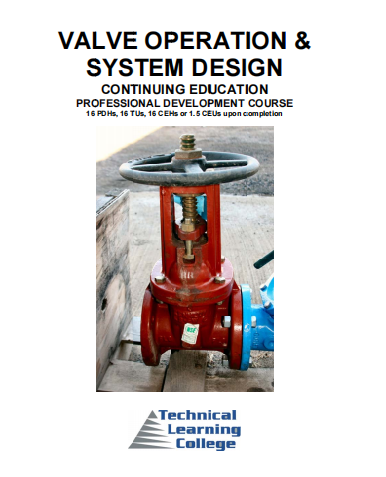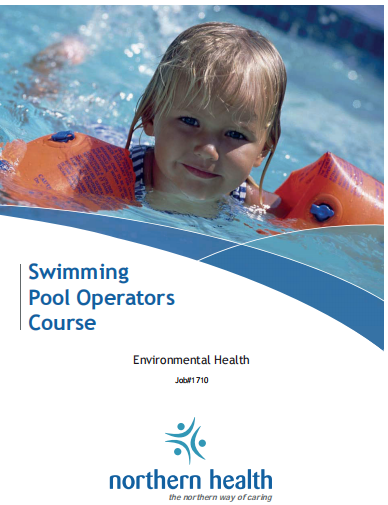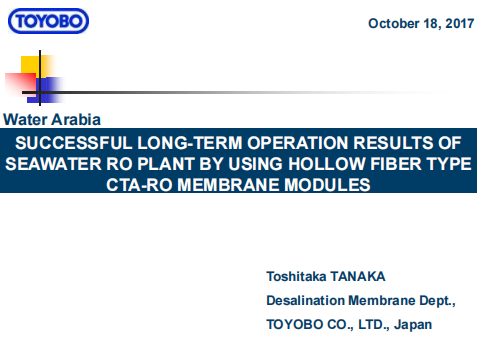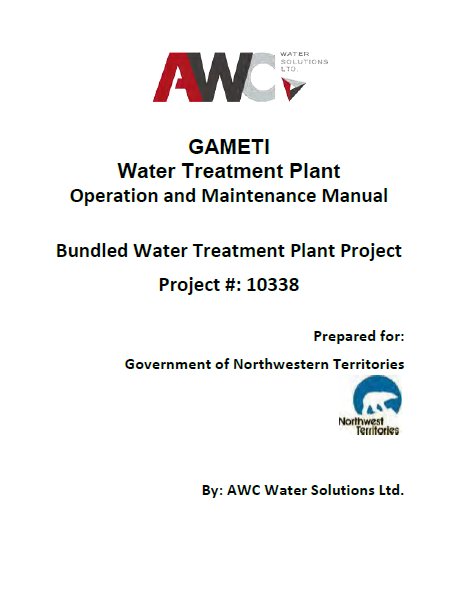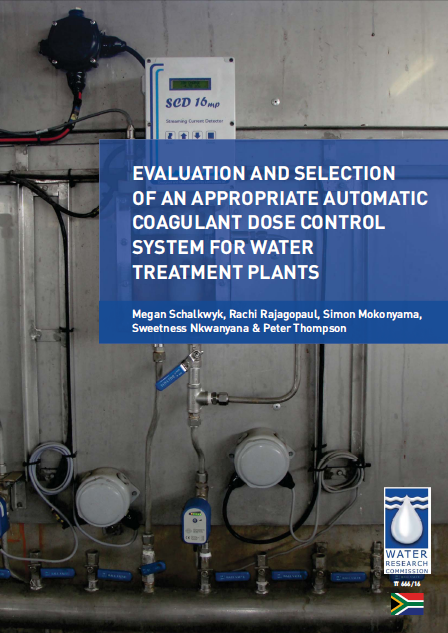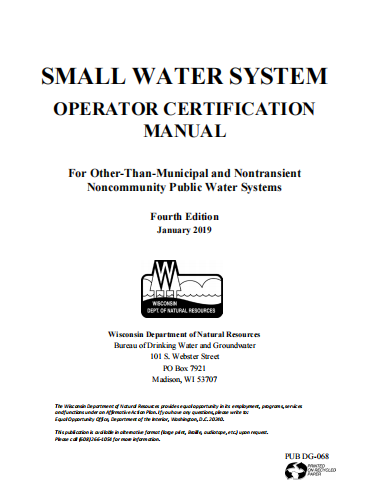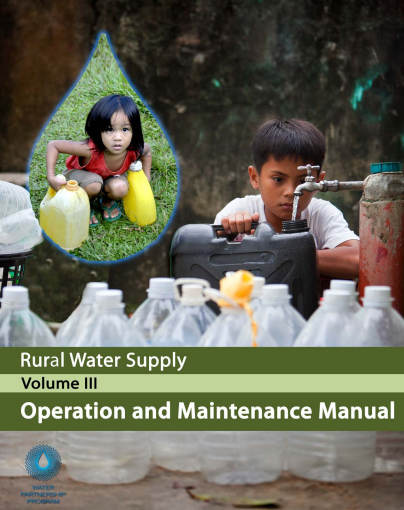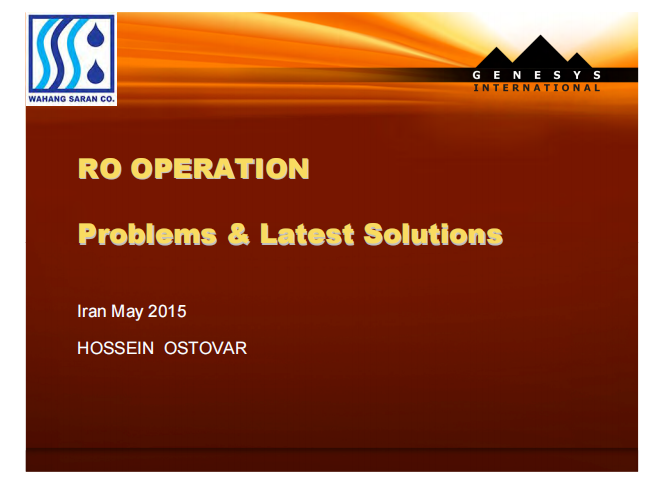Drinking Water Operator Guide Level 5
Introduction
This manual is intended to provide basic information for persons preparing to become operators of small public water systems, primarily Level 5 nontransient noncommunity water supplies and as a reference guide for existing Level 5
certified operators. It may also be of use for the operators of other small community systems; however, there are a few differences in some of the community versus noncommunity water supply regulations. The Safe Drinking Water Act; 1976 PA 399, as amended requires all community and nontransient noncommunity public water systems and certain transient noncommunity systems (those that treat for water quality purposes, or add chemicals to the water) to have a certified operator in responsible charge of the water system.
Drinking Water Operator Guide Level 5
Introduction
This manual is intended to provide basic information for persons preparing to become operators of small public water systems, primarily Level 5 nontransient noncommunity water supplies and as a reference guide for existing Level 5
certified operators. It may also be of use for the operators of other small community systems; however, there are a few differences in some of the community versus noncommunity water supply regulations. The Safe Drinking Water Act; 1976 PA 399, as amended requires all community and nontransient noncommunity public water systems and certain transient noncommunity systems (those that treat for water quality purposes, or add chemicals to the water) to have a certified operator in responsible charge of the water system.
Water Supply System Basic Operations
Introduction
- During this training module, we’ll be describing: Advantages and disadvantages of the two main water sources for municipal drinking water systems. Basic components of a water treatment system. Basic components of a water distribution system. Function and necessity of each component.
Water Supply System Basic Operations
Introduction
- During this training module, we’ll be describing: Advantages and disadvantages of the two main water sources for municipal drinking water systems. Basic components of a water treatment system. Basic components of a water distribution system. Function and necessity of each component.
Guidance for Preparing Standard Operating Procedures (SOPs)
Introduction
A Standard Operating Procedure (SOP) is a set of written instructions that document a routine or repetitive activity followed by an organization. The development and use of SOPs are an integral part of a successful quality system as it provides individuals with the information to perform a job properly, and facilitates consistency in the quality and integrity of a product or end-result. The term “SOP” may not always be appropriate and terms such as protocols, instructions, worksheets, and laboratory operating procedures may also be used. For this document “SOP” will be used.
Guidance for Preparing Standard Operating Procedures (SOPs)
Introduction
A Standard Operating Procedure (SOP) is a set of written instructions that document a routine or repetitive activity followed by an organization. The development and use of SOPs are an integral part of a successful quality system as it provides individuals with the information to perform a job properly, and facilitates consistency in the quality and integrity of a product or end-result. The term “SOP” may not always be appropriate and terms such as protocols, instructions, worksheets, and laboratory operating procedures may also be used. For this document “SOP” will be used.
Swimming Pool Operators Course
Introduction
For fun, fitness and relaxation, swimming is a popular activity. Due to our geography and climate, much swimming done by residents of and visitors occurs in swimming pools. Pool patrons expect to have an enjoyable experience in a clean and safe facility. However, if a pool is not designed and maintained properly, bathers are at risk of serious injury and disease. The BC Swimming Pool, Spray Pool and Wading Pool Regulations (hereafter referred to as “the Regulation”) states that: ‘Every swimming pool shall be operated and maintained by a competent operator and Manager. The Ministry of Health may require a certificate of competency obtained through attendance and successful completion of an approved swimming pool operator’s training course as evidence of compliance with this section. The responsible person for a pool must ensure that the pool is operated and maintained by a qualified person trained in pool operation, water chemistry, pool filtration and maintenance. This course is designed to assist pool operators in meeting the training requirements as set out in the regulation.
Swimming Pool Operators Course
Introduction
For fun, fitness and relaxation, swimming is a popular activity. Due to our geography and climate, much swimming done by residents of and visitors occurs in swimming pools. Pool patrons expect to have an enjoyable experience in a clean and safe facility. However, if a pool is not designed and maintained properly, bathers are at risk of serious injury and disease. The BC Swimming Pool, Spray Pool and Wading Pool Regulations (hereafter referred to as “the Regulation”) states that: ‘Every swimming pool shall be operated and maintained by a competent operator and Manager. The Ministry of Health may require a certificate of competency obtained through attendance and successful completion of an approved swimming pool operator’s training course as evidence of compliance with this section. The responsible person for a pool must ensure that the pool is operated and maintained by a qualified person trained in pool operation, water chemistry, pool filtration and maintenance. This course is designed to assist pool operators in meeting the training requirements as set out in the regulation.
Evaluation And Selection Of An Appropriate Automatic Coagulant Dose Control System For Water Treatment Plants
BACKGROUND
Due to the increased demand for safe drinking water, the impacts of climate change and the deterioration in the quality of raw water resources, drinking water service providers are under pressure to produce good quality potable water at an affordable price. Chemical dosing rates, especially coagulant dosing rates, affect both the quality of the final water and the cost of water treatment. Automatic coagulant dosing that is linked to the pertinent raw water parameters will optimise coagulant dosing, therefore decreasing costs and ensuring drinking water quality that complies with the South African National Standard for Drinking Water (SANS 241:2015).
Evaluation And Selection Of An Appropriate Automatic Coagulant Dose Control System For Water Treatment Plants
BACKGROUND
Due to the increased demand for safe drinking water, the impacts of climate change and the deterioration in the quality of raw water resources, drinking water service providers are under pressure to produce good quality potable water at an affordable price. Chemical dosing rates, especially coagulant dosing rates, affect both the quality of the final water and the cost of water treatment. Automatic coagulant dosing that is linked to the pertinent raw water parameters will optimise coagulant dosing, therefore decreasing costs and ensuring drinking water quality that complies with the South African National Standard for Drinking Water (SANS 241:2015).
Rural Water Supply Operation And Maintenance Manual
Introduction
The two main systems of measurement are the metric and the English systems. The metric system is also called the International Standard (SI) system. It has been accepted officially by practically all countries (a notable exception is the United States) and is used by all international scientific institutions and the United Nations. However, not all countries who have accepted it have been able to take the steps needed to fully convert from their previous system to the metric. This Manual will use the metric system primarily. It must be considered, however, that
much of the calibration of equipment in use in the water industry, as well as references, information, and standards (of which the US is a leading source) use measurements based on the English system. Thus, it is important to know both systems, and to be able to convert the measurements of one system to the other. The metric system is a decimal system based on 10, in which the higher- or lower-value units of measure are scaled by raising or reducing by a factor of 10. The basic measures of time, expressed in seconds, minutes, hours, days, months, and years, are common to both systems. However, decades (10 years), centuries (100 years), and millennia (1000) are graduated values that use the decimal or metric scale. This Chapter introduces the important units of measure that are frequently used in the establishment and operation of SSWP facilities. It also presents conversion tables and gives samples of how to convert from the English to the metric system.
Rural Water Supply Operation And Maintenance Manual
Introduction
The two main systems of measurement are the metric and the English systems. The metric system is also called the International Standard (SI) system. It has been accepted officially by practically all countries (a notable exception is the United States) and is used by all international scientific institutions and the United Nations. However, not all countries who have accepted it have been able to take the steps needed to fully convert from their previous system to the metric. This Manual will use the metric system primarily. It must be considered, however, that
much of the calibration of equipment in use in the water industry, as well as references, information, and standards (of which the US is a leading source) use measurements based on the English system. Thus, it is important to know both systems, and to be able to convert the measurements of one system to the other. The metric system is a decimal system based on 10, in which the higher- or lower-value units of measure are scaled by raising or reducing by a factor of 10. The basic measures of time, expressed in seconds, minutes, hours, days, months, and years, are common to both systems. However, decades (10 years), centuries (100 years), and millennia (1000) are graduated values that use the decimal or metric scale. This Chapter introduces the important units of measure that are frequently used in the establishment and operation of SSWP facilities. It also presents conversion tables and gives samples of how to convert from the English to the metric system.












